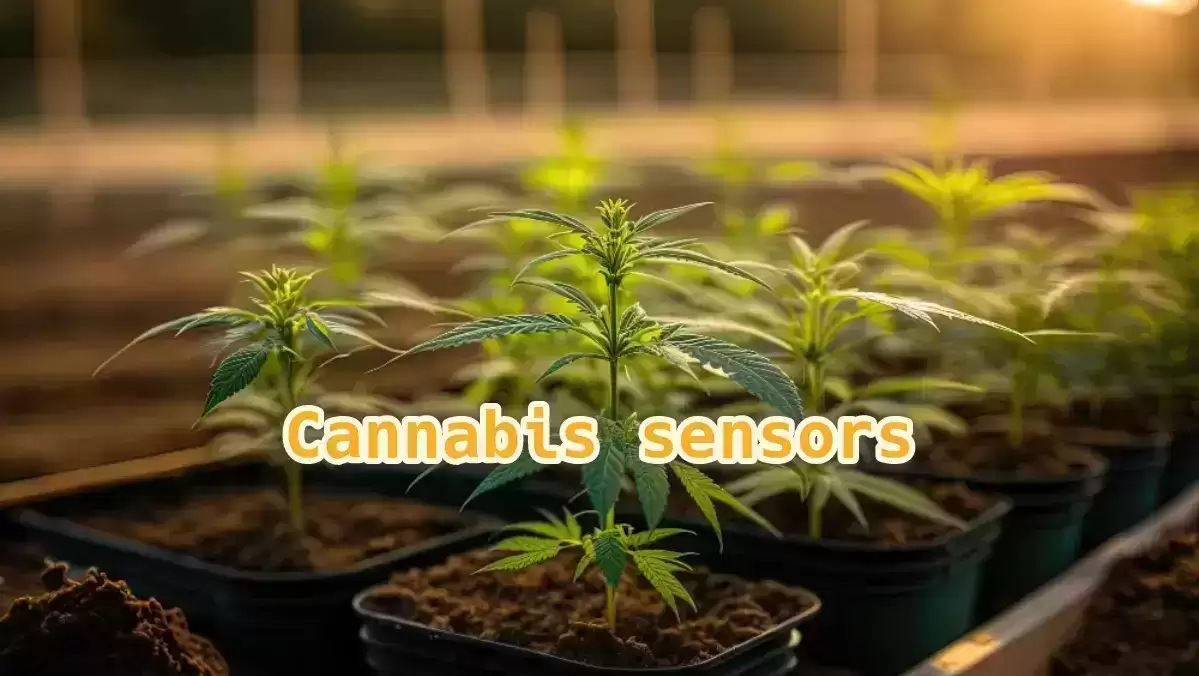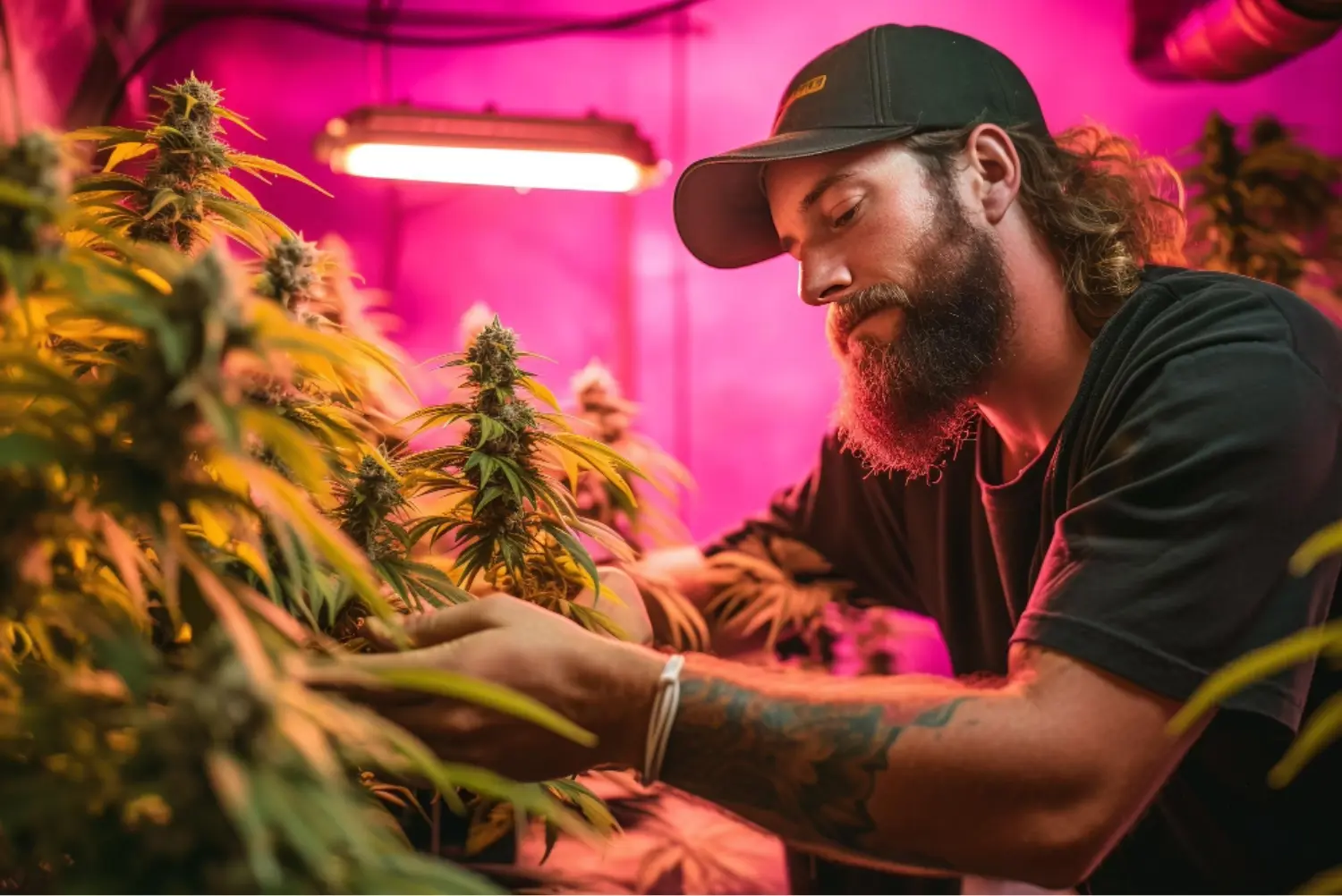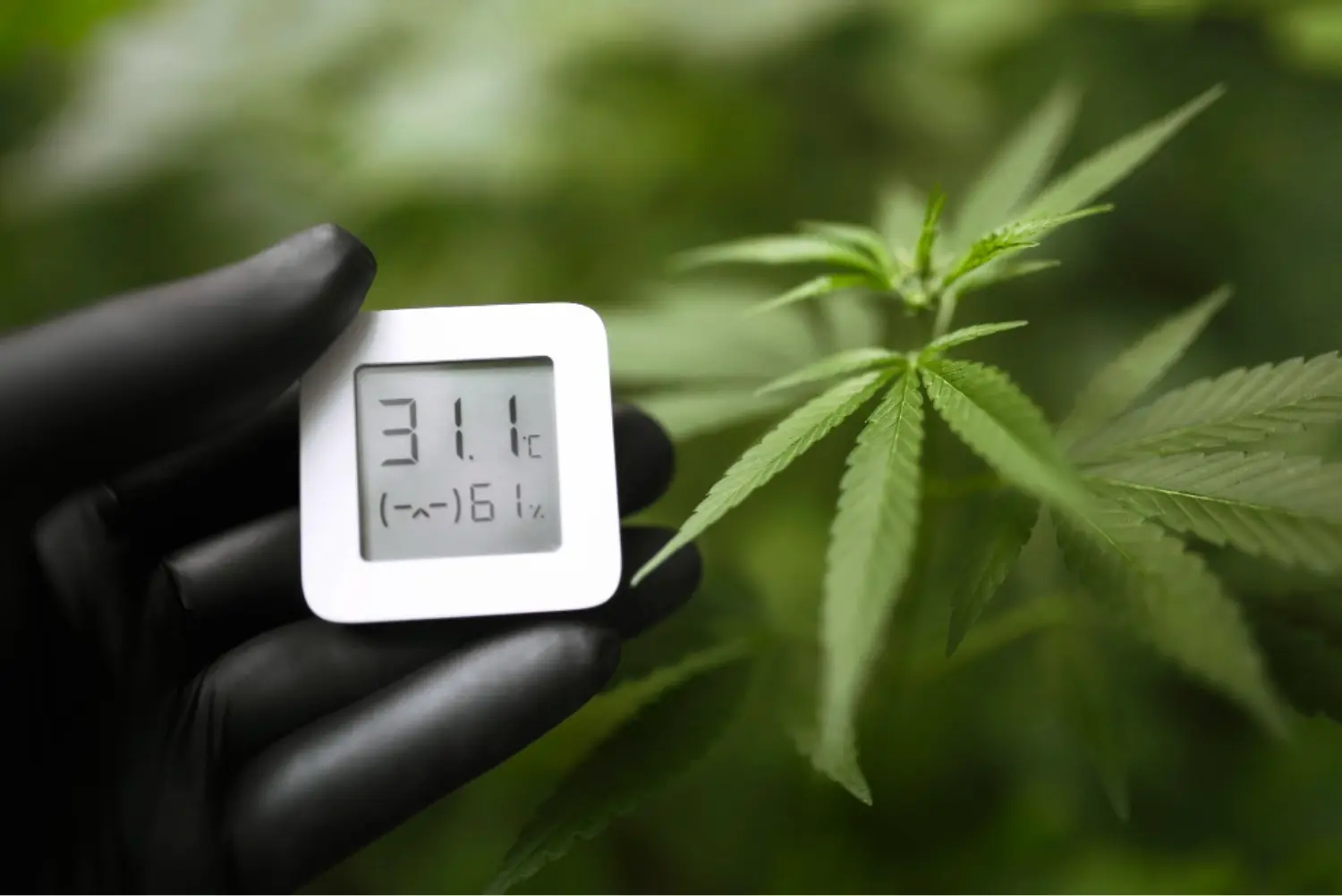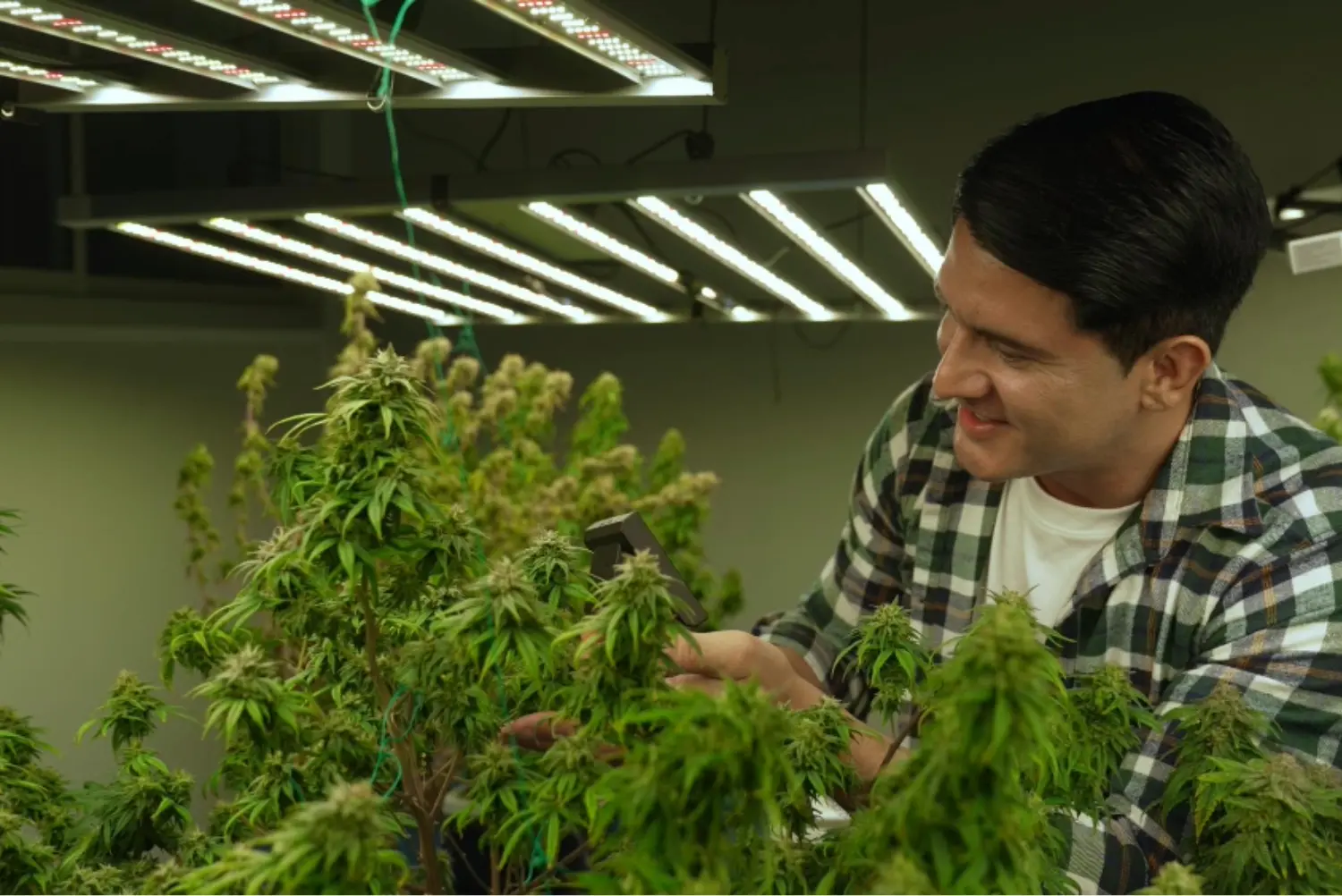
April 28, 2025

As the agricultural landscape continues to undergo constant change, the use of cutting-edge technology has become an essential component in the process of improving farming techniques. This is most clearly demonstrated in the world of cannabis growing, where sensors' accuracy has been recognized as a game-changer.
Cannabis growers have to deal with a wide variety of obstacles, which include environmental factors and the delicate equilibrium of nutrients, which are essential for the development of plants. Within this complex set of circumstances, sensors appear as vital instruments, giving farmers real-time data and insights that enable them to make decisions based on accurate information.
Sensors make up a comprehensive network that serves as the eyes and ears of the cultivation process. These sensors are responsible for monitoring external factors such as temperature, humidity, and light and analyzing soil moisture, nutrient levels, and pH.
Beyond the realm of simple observation, sensors represent a new era of precision agriculture, which makes it possible to fine-tune the conditions under which plants are grown. The influence of these technologies is made even stronger by automation, data analysis, and integration with intelligent systems, which promises to boost efficiency and optimize resource utilization. This article looks into the topic of cannabis sensors, shedding light on the best sensors for cannabis drying and the transforming impact these technological marvels have in searching forr optimal harvests and quality.
Cannabis cultivation presents numerous obstacles that demand innovative solutions. One of the most significant challenges is the plant's susceptibility to the conditions of its surrounding environment. Cannabis has a reputation for being extremely sensitive, and it suffers from severe reactions to changes in temperature, humidity, and light. Any variation from the optimum growth environment can affect the final product's yield and quality.
Achieving and maintaining the ideal growing environment becomes a delicate balancing act between the two. Pests and diseases add another level of complexity to the situation, as they present persistent dangers that call for careful attention and urgent management.

The legal landscape surrounding cannabis adds an additional layer of challenge. Maintaining careful records and observing particular cultivation methods are frequently required to comply with regulations.
Security concerns, which include preventing crop theft and maintaining compliance with local laws, add another complexity to the challenges that producers must overcome. When confronted with these problems, cannabis producers are increasingly turning to technology, particularly sensors, to navigate this challenging process.
To enhance the efficiency of growing operations, cannabis cultivators are integrating a wireless network, providing seamless connectivity that empowers real-time monitoring and control throughout their cultivation facilities.
Cannabis cultivators who are struggling to navigate the complexity of cultivation are finding that precision agriculture is what they need. Growers can now achieve a level of accuracy and control that was previously impossible, thanks to the use of modern technologies such as sensors. Growers can now modify conditions to fit the specific requirements of the cannabis plant thanks to these technologies, which enable real-time monitoring of environmental factors.
Environmental sensors, for instance, provide data on temperature, humidity, and light, empowering growers to create and maintain optimal conditions for growth. This allows growers to generate and sustain circumstances that are best for growth. On the contrary, soil sensors provide information about the levels of moisture and the nutrients present in the soil, enabling precise irrigation and fertilization methods to be implemented.
Furthermore, the automated capabilities of precision agriculture simplify labor-intensive operations, reducing the amount of work that cultivators have to do and minimizing the possibility of errors caused by an individual. Not only does this increase efficiency, but it also assists in preserving resources, which is essential to consider while sustainably cultivating cannabis.
Precision agriculture is a transformational force that is supporting the ongoing evolution of the cannabis business. It provides producers with the tools they require to overcome problems and cultivate with an unparalleled level of accuracy and efficiency.
In today's cultivation processes, cannabis sensors are the technological foundation that supports the industry. Real-time data essential for decision-making is provided by these devices, which are equipped with various sensors that help monitor a range of environmental factors, soil conditions, and plant health.
With the help of environmental sensors, producers are able to generate and maintain the optimal climate for cannabis cultivation. These sensors include temperature and humidity indicators, as well as light meters. Plants are protected from over- or under-irrigation by soil moisture sensors, guaranteeing that they receive the appropriate amount of water.

A more accurate application of fertilizers is made possible with the use of nutrient sensors, which measure the nutritional composition of the soil. To ensure that nutrients are absorbed, pH sensors are essential in preserving the delicate equilibrium of soil acidity or alkalinity.
The significance of cannabis sensors lies not just in data collection but in the actionable insights they provide. Growers can conduct focused actions, optimizing resource utilization and maximizing yield when they have a well-rounded understanding of the cannabis plant's complex biology. Wireless sensors, among all other types of sensors are not only gadgets but also important instruments that modern cannabis growers must have in their toolboxes. They provide them with the ability to navigate the problems of production with mastery and accuracy.
In the tricky process of cannabis cultivation, the factors of humidity and temperature have a significant effect on the plant's future. Sensors developed specifically for tracking these environmental factors are the hidden heroes of the current cannabis grower's arsenal. These advanced tools provide real-time data and knowledge that are essential for precise cultivation.
Temperature sensors carefully monitor the ambient heat to ensure that the cannabis plants grow in the ideal temperature range—not too hot, not too cold, but just right. The goal is to maximize growth potential by regulating enzymatic reactions, enhancing metabolic processes, and making the plants as comfortable as possible. Yet humidity sensors reveal the air's moisture level, which is vital for healthy cannabis growth.
Often part of comprehensive environmental monitoring systems, these sensors empower cultivators with data-driven precision. In the ever-changing world of cannabis growing, these sensors take on an extra protective role, ensuring that the ideal conditions are maintained for an abundant harvest.
The environment has a significant impact on cannabis, a plant with exceptional floral characteristics. A set of interdependent factors, the effect of environmental conditions on its growth is more than just a footnote; it can determine the difference between average and outstanding harvests. Several environmental factors, including light, temperature, humidity, and air circulation, control the complex interaction between photosynthesis, transpiration, and nutrient absorption.
Consider the role of light, an environmental influencer directing the plant's energy production. Too much or too little, and the delicate equilibrium falters. In this case, environmental sensors, especially those that measure light intensity, play monitors, ensuring the cannabis plant gets the perfect light contact for healthy growth.

Temperature, another pivotal player, influences metabolic rates, enzymatic activity, and overall plant health. In this case, sensors keep things from getting out of hand by avoiding temperature extremes that could cause stress or prevent growth. Humidity, the silent carrier of water vapor, can also have positive and negative effects. When the humidity is too high, mold growth becomes more likely; when it's too low, the plant dies from lack of water. The success of cannabis cultivation hinges on maintaining the delicate balance of relative humidity and air temperature, ensuring optimal growing conditions for healthy and thriving plants.
All of these environmental elements are interrelated and have a multiplicative influence on one another. By collecting data in real-time and allowing for fine-tuned modifications, environmental sensors give commercial growers the tools they need to manage these challenges.
Light, in the rich world of cannabis production, directs the plant's development with an accuracy that contradicts its apparent brightness. Light is essential to photosynthesis, the chemical process by which energy becomes life, and not only because it causes leaves to twirl in the sunlight. When it comes to cannabis, light's spectrum, intensity, and duration are not just details; they're also arranging plant growth.
Consider the spectrum—the nuanced hues within the light that dictate specific physiological responses. Cannabis has its preferences, just like any food expert. Spectra that are high in blue light encourage strong development and plentiful growth while plants are in the vegetative stage. Red light, with its warm embrace, stimulates the plant to produce a lot of buds as it begins to bloom. Cultivators who want to use their cannabis strains to their maximum genetic potential must understand and manipulate these spectral complexities.
Essential factors also include the brightness and duration of the light. Insufficient light can result in leggy, elongated plants. Conversely, too much light can burn the leaves, which causes stress and ultimately harms the plant. The cannabis plant, like a skilled performer, thrives in a carefully curated balance—a delicate interplay of light variables that speaks to the heart of cultivation.
In the field of cannabis growing, light sensors, the technological protectors of brilliant harmony, have emerged as game-changers. The cultivation process can achieve a degree of precision that is beyond the capabilities of the human eye because of the advanced tools equipped with the ability to measure light intensity, spectrum, and duration.
Today's cannabis industry relies on a sophisticated monitoring system to ensure compliance, enhance operational efficiency, and maintain stringent quality control throughout the cultivation and production processes. Fortunately, growers can adjust the light harmony with the help of light sensors, which guarantees that every stage of the cannabis plant's development receives the specific amount of light that it specifically requires.
Imagine being able to make adjustments to the spectral composition while the plants are in the vegetative phase of their growth and then effortlessly shift to a spectrum that is more favorable to flowering as the plants enter their reproductive stage. To provide growers with a level of control that cannot be achieved just via nature, light sensors enable growers to recreate the complex conditions of the sun inside the greenhouse.
Furthermore, these sensors improve environmental efficiency. Not only do growers improve the health of their plants by dynamically changing artificial lighting per the natural solar cycle, but they also reduce the amount of energy wasted from excessive use. Not only does this match with sustainable agricultural practices, but it also makes practical economic sense today when resource preservation is of the utmost importance.
In the tricky process of cannabis growing, the drying process, which is sometimes ignored, is a moment that can either make or break the plant. In this case, the complex nature of moisture levels, the potential for mold growth, and the preservation of terpenes become critical. Growvera ZONE enters this key stage with a declaration: no flashy claims, just a quiet revolution in the form of data-driven drying decisions.
With its one-of-a-kind on-plant sensors, Growvera has established itself as one of the market leaders in the cannabis drying industry. Even though it is sometimes overlooked, the drying process becomes the primary focus of accuracy and dependability. The sensors, which are strategically placed in various positions throughout your dry room, provide a comprehensive picture of the moisture levels, enabling you to have a thorough grasp of the state of your cannabis drying.
You can forget about the possibility of a decrease in profits and a decrease in product quality that comes with using single-point measurements. The company eliminates the guessing game that is connected with reaching the desired moisture content by providing continuous data points that are not damaging.
With Growvera, it is possible to perform remote monitoring from the convenience of your own home or place of business thanks to the real-time monitoring capabilities extending beyond your dry room's boundaries. The purpose of this is not only to make things more convenient but also to provide proactive alerting that enables you to handle concerns before they appear.
You will have your outcomes, such as improved product quality, greater yield through water weight optimization, avoidance of mold and mildew, and preservation of terpenes.
The growers who have used Growvera ZONE are not talking about a product but about a technology transforming the industry. Overall, cannabis growing facilities implement advanced sensor technology to optimize plant growth, creating an environment where precision and efficiency converge for the cultivation of robust and high-quality crops.
The role of sensors is crucial in ensuring that the soil remains in an ideal condition, which is not a fixed state but an equilibrium. These technological protectors, equipped with many capabilities, do more than observe; they take part in the story of cultivation.
For example, soil moisture sensors reveal the soil's hydration state in real-time. The delicate roots of cannabis need just the right amount of moisture, neither too much nor too little. This data is transmitted to growers by sensors. With this information, cultivators can control irrigation more precisely, preventing root suffocation in wet conditions and stress in dry ones. Not only does this lead to less water waste, but it also makes room for roots to spread out and grow. Overall, precision management of the root zone is a critical aspect of any successful cannabis growing operation, influencing nutrient uptake, plant development, and overall cultivation outcomes.
Beneath the surface, where roots engage with the earth, the role of nutrients becomes paramount. In order to achieve abundant and powerful harvests, cannabis growers must carefully monitor the complex interactions between soil elements. The technological methods known as nutrient sensors have arrived, allowing cannabis cultivators to see the chemical spectrum nourishing their plants.
Nitrogen, phosphorus, and potassium are the keystones of plant nutrition, and nutrient sensors act as the translators of their concentrations in the soil. The wonderful thing about these sensors is that they can help growers deal with the ever-changing requirements of cannabis at different stages of its growth and accurately measure nutrient levels. By being aware of the fluctuations in nutrient availability, growers may adjust their fertilization methods to provide plants with precisely what they need for strong development and growth.
Nutrient sensors go beyond conventional farming methods and are commonly used in soil monitoring systems. Their accuracy turns nutrition management into a science. The goal of this careful cultivation is not merely to maximize productivity but to produce cannabis with ideal cannabinoid and terpene profiles, resulting in a harvest that surpasses expectations in terms of both quantity and quality.
In the complicated world of cannabis growing, where every detail counts, the soil's pH level is crucial in determining success. Here are pH sensors, saviors for equilibrium. Not only is the soil's acidity or alkalinity measured by the pH scale, but it also influences nutrient availability, microbial activity, and, ultimately, the vitality and health of cannabis plants.
With pH sensors, growers can gain real-time insights into the complicated chemistry beneath the surface. Because of its acidic taste, cannabis does best in carefully controlled environments. These sensors watch over this fine balance and notify growers when the pH drops too low or too high. With this data, cultivators may set up conditions for optimal nutrient uptake by precisely adjusting the pH or alkalinity.
Keeping the soil at an ideal pH level is much more than simply avoiding harsh conditions; it's about establishing a balanced ecosystem in which cannabis can flourish. When water is too acidic, minerals like magnesium and calcium are inaccessible, and when it's too alkaline, the danger of nutrient deficiencies increases. pH sensors empower growers to navigate this complex process, ensuring that the soil remains fertile where the cannabis plant can express its full genetic potential.
Looking into the fundamentals of precision agriculture, comprehending the real-time data collection process via sensors reveals a complex and game-changing technological network. The cultivation realm's guardians, the sensors, move with a skill that surpasses simple observation. Their role is dynamic, responsive, and integral to the flow of the cultivation process.
At the core of this real-time data collection is the support of sensors tuned to monitor various environmental parameters. Every sensor in the system is like a little influencer tuned to a different part of the growing environment, whether it's the soil's moisture level, light intensity, humidity, or temperature. Like a network of watchful monitors, these sensors are placed strategically to ensure that no part of the growing process goes unnoticed.
All the magic happens when these sensors continually communicate with the primary data center. Cultivators can stay up-to-date on the constantly changing conditions in the cultivating space with the help of real-time data streaming.
The accessibility of the data is equally as stunning as the data itself. Thanks to data processing and communication developments, growers may now remotely access this real-time data. They now can monitor and respond to their plants' needs from almost anywhere using a computer, tablet, or smartphone. This new age of today's data collection is more than a technological advancement; it represents a change in agriculture, with cultivators being at the center of all activity and knowledge.
With the arrival of a new era in agriculture, sensors play a crucial role in automating growing processes, leading growers to achieve unparalleled precision and efficiency. Sensors play a pivotal role in cultivating.
A complete system regulating different cultivation parts is the starting point for the automation journey. Sensors are integrated into this system. A network of environmental, nutritional, and light sensors works with other automated devices and systems to provide seamless interaction. The cooperation of sensors and automation is transformative, departing from traditional, labor-intensive cultivation practices.
Consider the irrigation process, for instance. In conjunction with soil moisture sensors, automatic irrigation systems guarantee that plants get the exact quantity of water they require, eliminating the uncertainty and possibility of human mistakes. Similarly, automated lighting systems work with light sensors to change the spectral content and intensity of the light throughout the day, creating a remarkably accurate effect in simulating the natural solar cycle.
This automation has far-reaching consequences that go beyond mere convenience. It's a strategic approach to resource optimization. Simplifying labor-intensive processes allows growers to devote more time to strategic decision-making and less to ordinary, repetitive duties. By adapting to each plant's unique requirements, automated systems can save water and energy without sacrificing performance.
In the intricate tapestry of cannabis cultivation, where every detail matters, the role of sensors emerges as a silent yet transformative force. The journey through the cultivation process, from environmental monitoring to nutrient management, leads to the often-underestimated realm of drying—a make-or-break phase that requires precision and foresight. In this journey, Growvera's sensors for cannabis drying take center stage, not as mere instruments but as guardians of quality, yield, and the essence of the plant.
Environmental sensors monitor things like light, humidity, and temperature to ensure the cannabis plant is always in the best possible environment. With its on-plant sensors, Growvera ZONE is more than just a tool; it guarantees a successful drying procedure.
Disclaimer: This material is for informational purposes only and should not be relied on for legal, medical, financial, or any other form of professional advice.